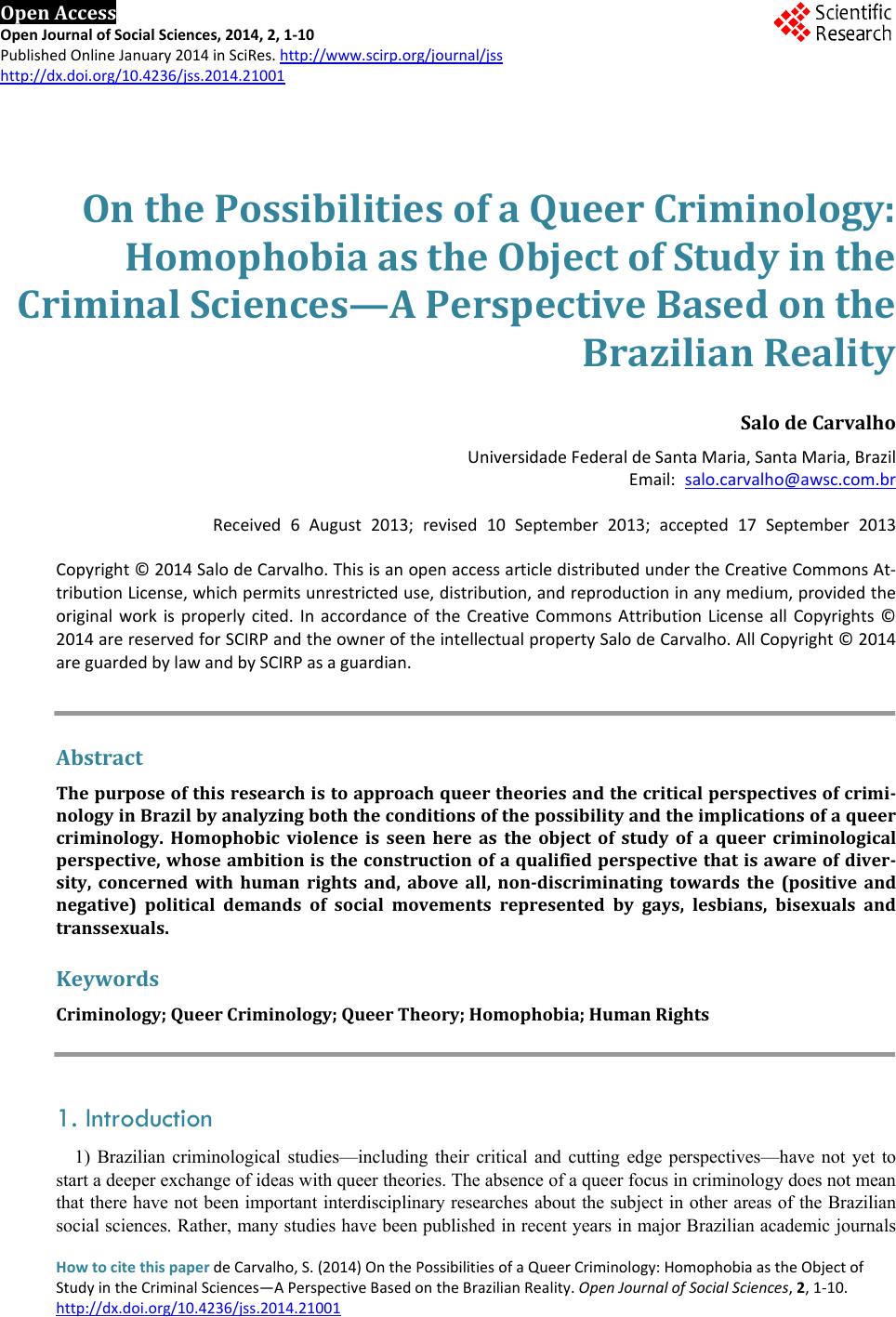 Open Access Open Journal of Social Sciences, 2014, 2, 1-10 Published Online January 2014 in SciRes. http://www.scirp.org/journal/jss http://dx.doi.org/10.4236/jss.2014.21001 How to cite this paper de Carvalho, S. (2014) On the Possibilities of a Queer Criminology: Homophobia as the Object of Study in the Criminal Sciences—A Perspective Based on the Brazilian Reality. Open Journal of Social Sciences, 2, 1-10. http://dx.doi.org/10.4236/jss.2014.21001 On the Possibilities of a Queer Criminology: Homophobia as the Object of Study in the Criminal Sciences—A Perspective Based on the Brazilian Reality Salo de Carvalho Universidade Federal de Santa Maria, Santa Maria, Brazil Email: salo.carvalho@awsc.com.br Received 6 August 2013; revised 10 September 2013; accepted 17 September 2013 Copyright © 2014 Salo de Carvalho. This is an open access article distributed under the Creative Commons At- tribution License, which permits unrestricted use, distribution, and reproduction in any medium, provided the original work is properly cited. In accordance of the Creative Commons Attribution License all Copyrights © 2014 are reserved for SCIRP and the owner of the intellectual property Salo de Carvalho. All Copyright © 2014 are guarded by law and by SCIRP as a guardian. Abstract The purpose of this research is to approach queer theories and the critical perspectives of crimi- nology in Brazil by analyzing both the conditions of the possibility and the implications of a queer criminology. Homophobic violence is seen here as the object of study of a queer criminological perspective, whose ambition is the construction of a qualified perspective that is aware of diver- sity, concerned with human rights and, above all, non-discriminating towards the (positive and negative) political demands of social movements represented by gays, lesbians, bisexuals and transsexuals. Keywords Criminology ; Queer Criminology; Queer Theory; Homophobi a; Human Rights 1. Introduction 1) Brazilian criminological studies—including their critical and cutting edge perspectives—have not yet to start a deeper exchange of ideas with queer theories. The absence of a queer focus in criminology does not mean that there have not been important interdisciplinary researches about the subject in other areas of the Brazilian social sciences. Rather, many studies have been published in recent years in major Brazilian academic journals 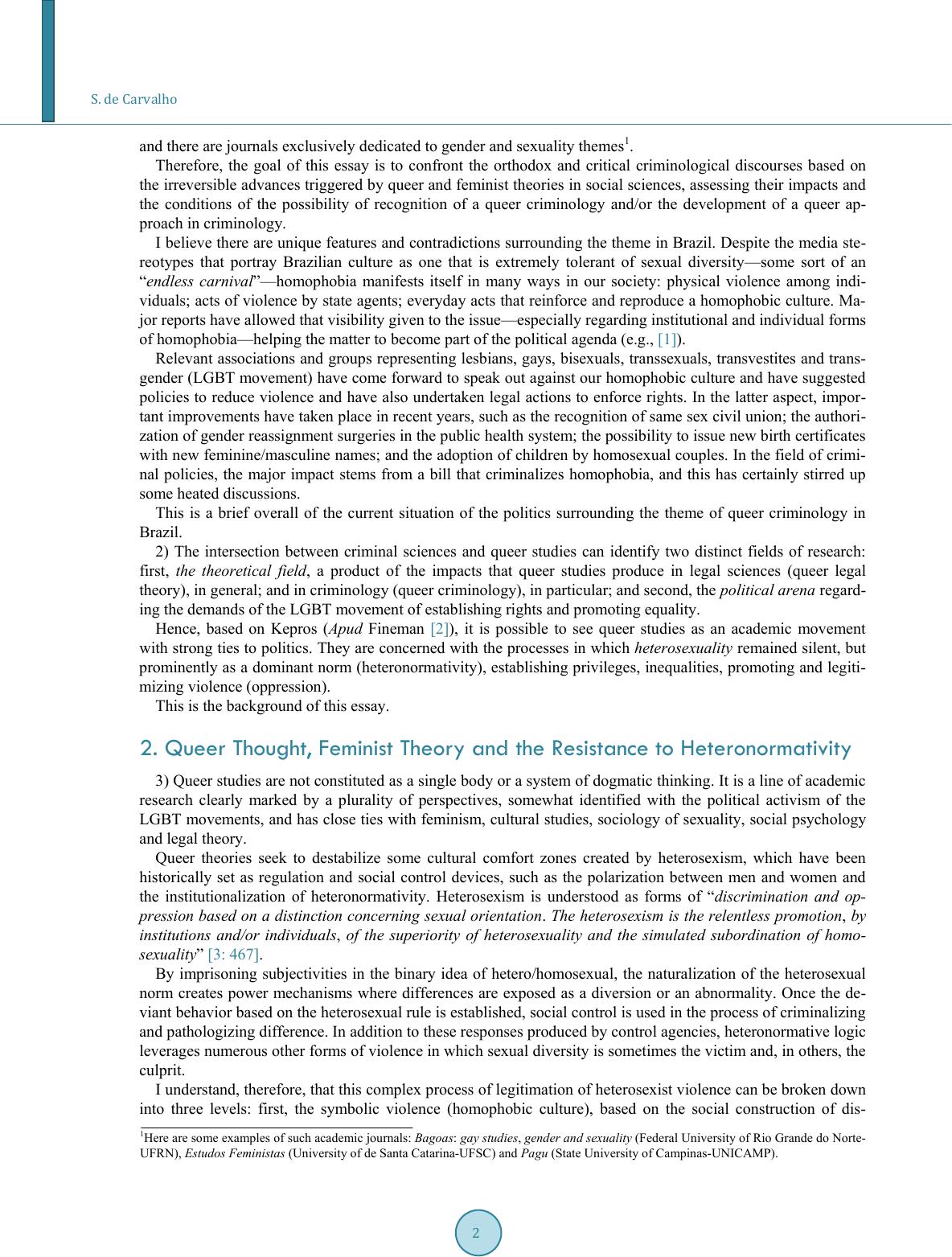 S. de Carvalho and there are journals exclusively dedicated to gender and sexuality themes1. Therefore, the goal of this essay is to confront the orthodox and critical criminological discourses based on the irreversible advances triggered by queer and feminist theories in social sciences, assessing their impacts and the conditions of the possibility of recognition of a queer criminology and/or the development of a queer ap- proach in criminology. I believe there are unique features and contradictions surrounding the theme in Brazil. Despite the media ste- reotypes that portray Brazilian culture as one that is extremely tolerant of sexual diversity—some sort of an “endless carnival”—homo phobia manifests itself in many ways in our society: physical violence among indi- viduals; acts of violence by state agents; everyday acts that reinforce and reproduce a homophobic culture. Ma- jor reports have allowed that visibility given to the issue—especially regarding institutio nal and individual forms of homophobia—helping the matter to become part of the political agenda (e.g., [1]). Relevant associations and groups representing lesbians, gays, bisexuals, transsexuals, transvestites and trans- gender (LGBT movement) have come forward to speak out against our homophobic culture and have suggested policies to reduce violence and have also undertaken legal actions to enforce rights. In the latter aspect, impor- tant improvements have taken place in recent years, such as the recognition of same sex civil union; the authori- zation of gender reassignment surge ries in the public health system; the possib ility to issue new birth certificates with new feminine/masculine names; and the adop tion of children by homosexu al couples. In the field of cr imi- nal policies, the major impact stems from a bill that criminalizes homophobia, and this has certainly stirred up some hea t e d discussions. This is a brief overall of the current situation of the politics surrounding the theme of queer criminology in Brazil. 2) The intersection between criminal sciences and queer studies can identify two distinct fields of research: first, the theoretical field, a product of the impacts that queer studies produce in legal sciences (queer legal theory), in general; and in criminology (queer criminology), in particular; and second, the political ar ena regard- ing the demands of the LGBT movement of establishing rights and promoting equality. Hence, based on Kepros (Apud Fineman [2]), it is possible to see queer studies as an academic movement with strong ties to politics. They are concerned with the processes in which heterosexuality remained silent, but prominently as a dominant norm (heteronormativity), establish ing privileges, inequalities, promoting and legiti - mizing violence (oppression). This is the background of this essay. 2. Queer Thought, Feminist Theory and the Resistance to Heteronormativity 3) Queer studies are not constituted as a single body or a system of dogmatic thinking. It is a line of academic research clearly marked by a plurality of perspectives, somewhat identified with the political activism of the LGBT movements, and has close ties with fe minism, cultural studies, sociology of sexuality, social psychology and legal theory. Queer theories seek to destabilize some cultural comfort zones created by heterosexism, which have been historically set as regulation and social control devices, such as the polarization between men and women and the institutionalization of heteronormativity. Heterosexism is understood as forms of “discrimination and op- pression based on a distinction concerning sexual orientation. The heterosexism is the relentless promotio n, by institutions and/or individuals, of the superiority of heterosexuality and the simulated subordination of homo- sexuality” [3: 467]. By imprisoning subjectivities in the binary idea of hetero/homosexual, the naturalization of the heterosexual norm creates power mechanisms where differences are exposed as a diversion or an abnormality. Once the de- viant behavior based on the heterosexual rule is established, social control is used in the process of criminalizing and pathologizing difference. In addition to these responses produced by control agencies, heteronormative logic leverages numerous other forms of violence in which sexual diversity is sometimes the victim and, in others, the culprit. I understand, therefore, that this complex process of legitimation of heterosexist violence can be broken down into three levels: first, the symbolic violence (homophobic culture), based on the social construction of dis- 1Here are some examples of su ch aca d e mic journals: Bagoas: gay studies, gender and sexuality (Federal University of Rio Grande d o Norte- UFRN), Estudos Feministas (University of de Santa Catarina-UFSC) and Pagu (State University of Campinas-UNICAMP). 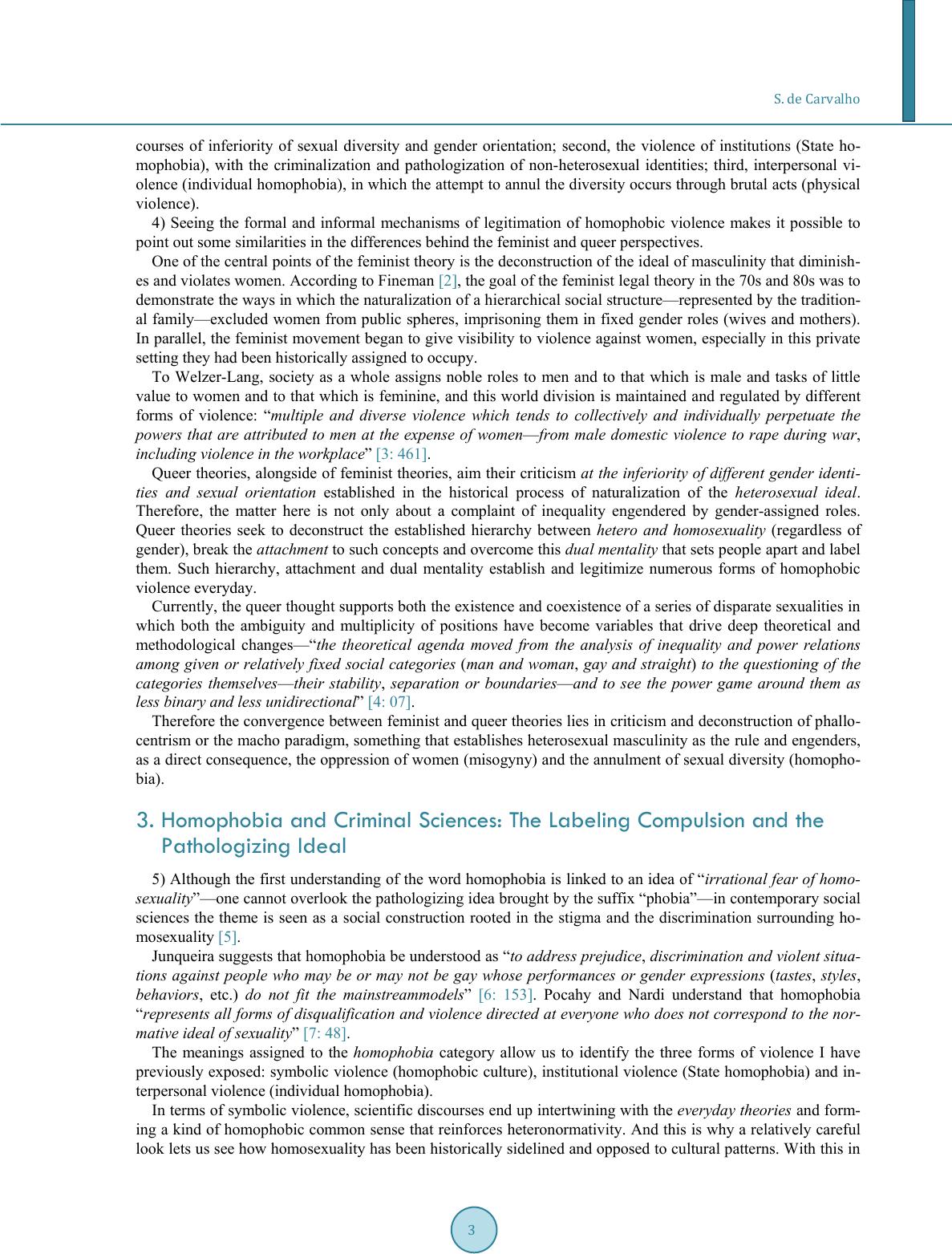 S. de Carvalho courses of inferiority of sexual diversity and gender orientation; second, the violence of institutions (State ho- mophobia), with the criminalization and pathologization of non-heterosexual identities; third, interpersonal vi- olence (individual homophobia), in which the attempt to annul the diversity occurs through brutal acts (physical violence). 4) Seeing the formal and informal mechanisms of legitimation of homophobic violence makes it possible to point out some similarities in the differences behind the feminist and queer perspectives. One of the central points of the feminist theory is the deconstruction of the ideal of masculinity that diminish- es and violates women. According to Fineman [2], the goal of the feminist legal theory in the 70s and 80s was to demonstrate the ways in which the naturalization of a hierarchical social structure—represented by the tradition- al family—excluded women from public spheres, imprisoning them in fixed gender roles (wives and mothers). In parallel, the feminist movement began to giv e visibility to violence against women, especially in this private setting they had been historically assigned to occupy. To Welzer-Lang, society as a whole assigns noble roles to men and to that which is male and tasks of little value to women and to that which is feminine, and this world division is maintained and regulated by different forms of violence: “multiple and diverse violence which tends to collectively and individually perpetuate the powers that are attributed to men at the expense of women—from male domestic violence to rape during war, including violence in the workplace” [3: 461]. Queer theories, alongside of feminist theories, aim their criticism at the inferiority o f different gender identi- ties and sexual orientation established in the historical process of naturalization of the heter osexual ideal. Therefore, the matter here is not only about a complaint of inequality engendered by gender-assigned roles. Queer theories seek to deconstruct the established hierarchy between hetero and homosexuality (regardless of gender), break the attachment to such concepts and overcome this dual mentality that sets people apart and label them. Such hierarchy, attachment and dual mentality establish and legitimize numerous forms of homophobic violence everyday. Currently, the queer thought supports both the existence and coexistence of a series of disparate sexualities in which both the ambiguity and multiplicity of positions have become variables that drive deep theoretical and methodological changes—“the theoretical agenda moved from the analysis of inequality and power relations among given or relatively fixed social categories (man and woman, gay and straight) to the questioning of the categories themselves—their stability, separation or boundaries—and to see the power game around them as less binary and less unidirectional” [4: 07]. Therefore the convergence between feminist and queer theories lies in criticism and deconstruction of phallo- centrism or the macho paradigm, something that establishes heterosexual masculinity as the rule and engenders, as a direct consequence, the oppression of women (misogyny) and the annulment of sexual diversity (homopho- bia). 3. Homophobia and Criminal Sciences: The Labeling Compulsion and the Pathologizing Ideal 5) Although the first understanding of the word homophobia is linked to an idea of “irrational fear of homo- sexuality”—one cannot overlook the pathologizing idea brought by the suffix “phobia”—in contemporary social sciences the theme is seen as a social construction rooted in the stigma and the discrimination surrounding ho- mosexuality [5]. Junqueira suggests that homophobia be understood as “to address prejudice, discrimination and violent situa- tions against people who may be or may not be gay whose performances or gender expressions (tastes, styles, behaviors, etc.) do not fit the mainstreammodels” [6: 153]. Pocahy and Nardi understand that homophobia “represents all fo rms of disqualification and vio lence directed at everyone who doe s not correspond to the nor - mative ideal of sexuality” [7: 48]. The meanings assigned to the homophobia category allow us to identify the three forms of violence I have previously exposed: symbolic violence (homophobic culture), institutional violence (State homophobia) and in- terpersonal violence (individual homophobia). In terms of symbolic violence, scientif ic discourses end up intertwining with the everyday theories and form- ing a kind of homophob ic common sense that reinf orces heteronormativity. And this is why a relatively careful look lets us see how homosexuality has been historically sidelined and opposed to cultural patterns. With this in  S. de Carvalho mind, it is possible to observe an endurance of that inquisitorial mind set of identifying sexual deviance as a sin in the modern sciences. For Foucault, the formation of a real scien tific system about sex in the West begins with the hunting of peri- pheral sexualities tha t entailed an incorporation of perversions and a new specification of individuals. Thus, the 19th century homosexual is transformed into a personage: “a past, a history, and a childhood, a character, a type of life, also a morphology, with an ind iscreet anatom y and possibly a myste rious physiology” [8: 43]. If the sodomite was a recidivist, the homosexual is a species to be studied and classified among the many perversions nominated by psychiatry and criminology during the 19th century. 6) In the field of criminal sciences, Groombridge [9], in his influential study on the possibilities of a queer criminology, proposes an interesting reflection: criminology, since its historical founda tion in the positivist ma- trix would not have been a queer criminology? According to the author, somehow it would be possible to present a positive response, especially because the lombrosian image of the deviant is marked by sharp traits that expose the homoerotic exaggeration of anatomical features of male bodies as, e.g., the developed muscles and huge genitals. Besides provoking his readers, Groombridge shows how the scientific project of classification of the homo criminal is directly connected to the idea of the first sexologists to map sexual deviance. Hence, both approaches ultimately establish a homogeneous control system of two related forms of abnormality: criminal behavior and sexual perversion. In this scenario, “while the sexologists sought to classify the inverted male as different from the normal male, criminologists were defining the criminal male as different from the normal male” [9: 534]. Although issues related to sexuality are not central to the lombrosian research, Groombridge highlights the natural incorporation of heteronormativity by positivist criminology. In a model of orthodox science, marked both by moralizing and normalizing references, heterosexual masculinity is viewed as a resource to interpret the deviant and a model for cataloging pathologies. It is also important to remember that the positivist model understands both crime and the delinquent as the barbarian remains of mankind that must be either controlled, or extinguished, or regenerated through technique (psychiatry, criminology, criminal law). Criminology is assigned the role of canceling the last vestige of barbar- ism. The deviant therefore represents the denial of civilized men and crime externalizes moral values opposed to those of culture. The procedures of orthodox criminology aimed at identifying, analyzing, intervening, abolish- ing (or converting) deviants—among them gays, called “inverted” by early sexologists—are epistemologically grounded in the ideal of heterosexu ality. With this in mind, one can argue that the constitution of scientific cri- minology is a homophobic one, as well as numerous other sciences that pathologize sexual d iversity, especially psychiatry. It is important to und erstand, ther efore, how this lab eling proces s of d iversity—typical of scientific positivis m —produces reifying deviant identities. The reifying process involves freezing and identifying the deviant pa- thology as its own identity. The offense is interpreted as an innate power, as an attribute of individual that will eventually surface, revealing a hidden part of his existence: his criminal essence. The identification of the act with perpetrator locks past and future in the image of deviance: a confinement of the past because his history is interpreted only as a sequence of preparatory acts for the offense and an imprisonment of the future because committing the crime marks an inexorable tendency to repetition. The gender deviation and the deviant sexual behavior are traits of a potentially criminal pathological perso- nality that resists the heteronormative standard. The reifying of sexual preference as a deviant identity happens because “nothing that went into his total composition was unaffected by his sexua lity. It was everywhere present in him: at the root of all his actions because it was their insidious and indefinitely active principle; written im- modestly on his face and body because it was a secret that always gave itself away” [8: 43]. Homophobia is therefore a political and scientific defense of heteronormativity against heretical sexualities, establishing hierarchies and inequ a lities that materialize in discourses and acts of violence. 4. Three Discontinuous Rupture Movements with Orthodox Criminology 7) The first movement that I would like to highlight in the process of depathologization of both the delin- quency and the delinquent is the one derived from the Chicago School that leads to the labeling approach. Sutherland is one of the first criminolog ists to categorically state that the assumptions of pos itivist criminolo - gy are invalid, not only because they are not applicable to the crime of the upper classes, but because they don’t 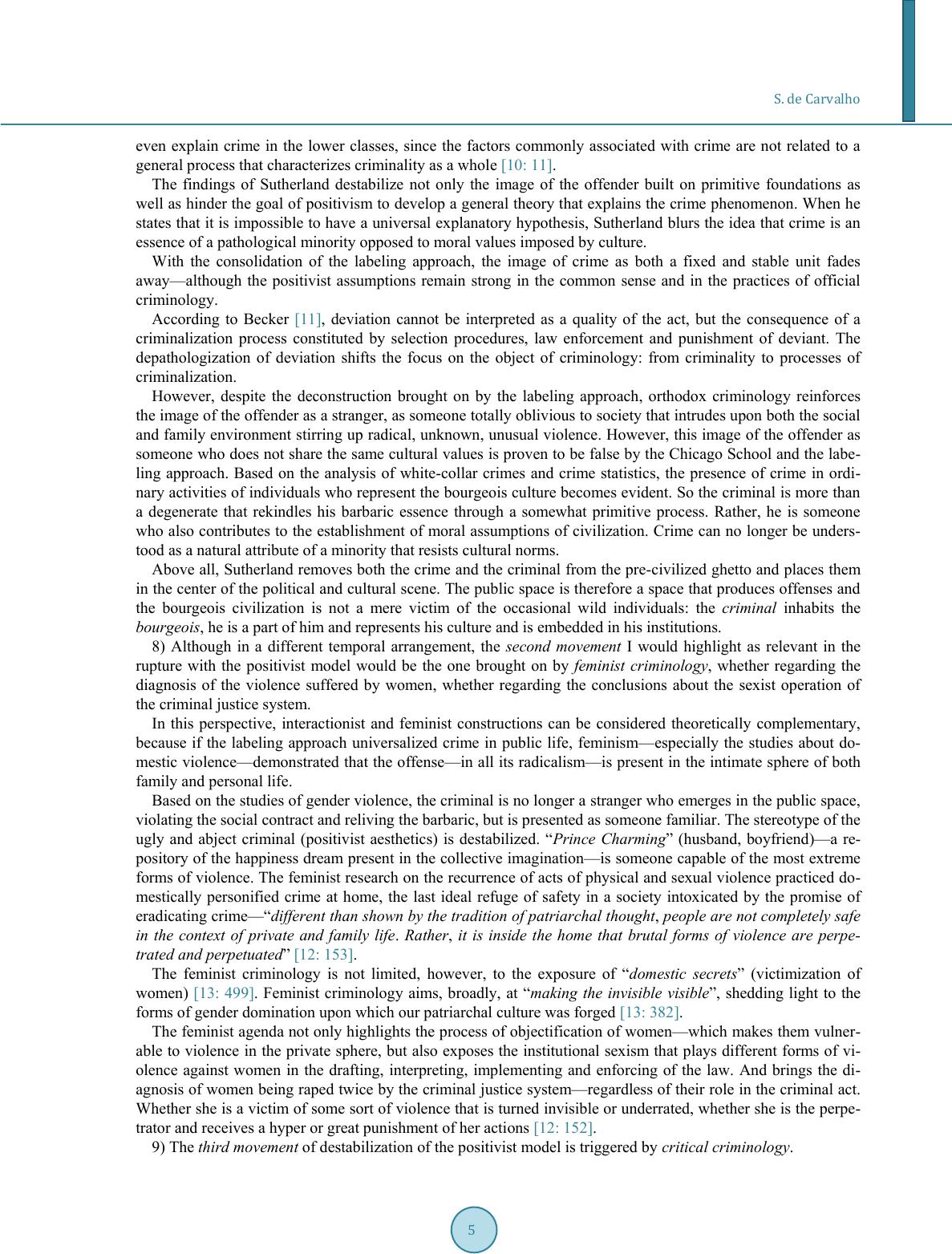 S. de Carvalho even explain crime in the lower classes, since the factors commonly associated with crime are not related to a general process that characterizes criminality as a whole [10: 11]. The findings of Sutherland destabilize not only the image of the offender built on primitive foundations as well as hinder the goal of positivism to develop a general theory that explains the crime phenomenon. When he states that it is impossib le to have a universal explanatory hypothesis, Sutherland blurs the idea that crime is an essence of a pathological minority opposed to moral values imposed by culture. With the consolidation of the labeling approach, the image of crime as both a fixed and stable unit fades away—although the positivist assumptions remain strong in the common sense and in the practices of official criminology. According to Becker [11], deviation cannot be interpreted as a quality of the act, but the consequence of a criminalization process constituted by selection procedures, law enforcement and punishment of deviant. The depathologization of deviation shifts the focus on the object of criminology: from criminality to processes of criminalization. However, despite the deconstruction brought on by the labeling approach, orthodox criminology reinforces the image of the offender as a stranger, as someone totally oblivious to society that intrudes upon both the social and family en vironment stirring up r adical, unknown, unusual violence. However, this image of the offender as someone who does not share the same cultural values is proven to be false by the Chicago School and the labe- ling approach. Based on the analysis of white-collar crimes and crime statistics, the presence of crime in ordi- nary activities of individuals who represent the bourgeois culture becomes evident. So the criminal is more than a degenerate that rekindles his barbaric essence through a somewhat primitive process. Rather, he is someone who also contributes to the establishment of moral assumptions of civilization. Crime can no longer be unders- tood as a natural attribute of a minority that resists cultural norms. Above all, Sutherland removes both the crime and the criminal from the pre-civilized ghetto and places them in the center of the political and cultural scene. The public space is therefore a space that produces offenses and the bourgeois civilization is not a mere victim of the occasional wild individuals: the criminal inhabits the bourgeois, he is a part of him and represents his culture and is embedded in his institutions. 8) Although in a different temporal arrangement, the second movement I would highlight as relevant in the rupture with the positivist model would be the one brought on by feminist criminology, whether regarding the diagnosis of the violence suffered by women, whether regarding the conclusions about the sexist operation of the criminal justice system. In this perspective, interactionist and feminist constructions can be considered theoretically complementary, because if the labeling approach universalized crime in public life, feminism—especially the studies about do- mestic violence—demonstrated that the offense—in all its radicalism—is present in the intimate sphere of both family and personal life. Based on the studies of gender violence, the criminal is no longer a stranger who emerges in the public space, violating the social contract and re liv ing the barbaric, but is presented as someone familiar. The stereotype of the ugly and abject criminal (positivist aesthetics) is destabilized. “Prince Charming” (husband, boyfriend)—a re- pository of the happiness dream present in the collective imagination—is someone capable of the most extreme forms of violence. The feminist research on the recurrence of acts of physical and sexual violence practiced do- mestically personified crime at home, the last ideal refuge of safety in a society intoxicated by the promise of eradicating crime—“different than shown by the tradition of patriarchal thought, people are not completely safe in the context of private and family life. Rather, it is inside the home that brutal forms of violence are perpe- trated a nd perpetuat ed” [12: 15 3] . The feminist criminology is not limited, however, to the exposure of “domestic secrets” (victimization of women) [13: 499]. Feminist criminology aims, broadly, at “making the invisible visible”, shedding light to the forms of gender dominati on upon whi c h o ur patria r chal cul ture was f or ged [13: 382] . The feminist agenda not only highlights the process of objectification of women—which makes them vulner- able to violence in the private sphere, but also exposes the institutional sexism that plays different forms of vi- olence against women in the drafting, interpreting, implementing and enforcing of the law. And brings the di- agnosis of women being raped twice by the criminal justice system—regardles s of their role in the criminal act. Whether she is a victim of some sort of violence that is turned invisible or underrated, whether she is the perpe- trator and receives a hyper or great punishment of her actions [12: 152]. 9) The t hird move m ent of destabilization of the positivist model is triggered by critical criminology. 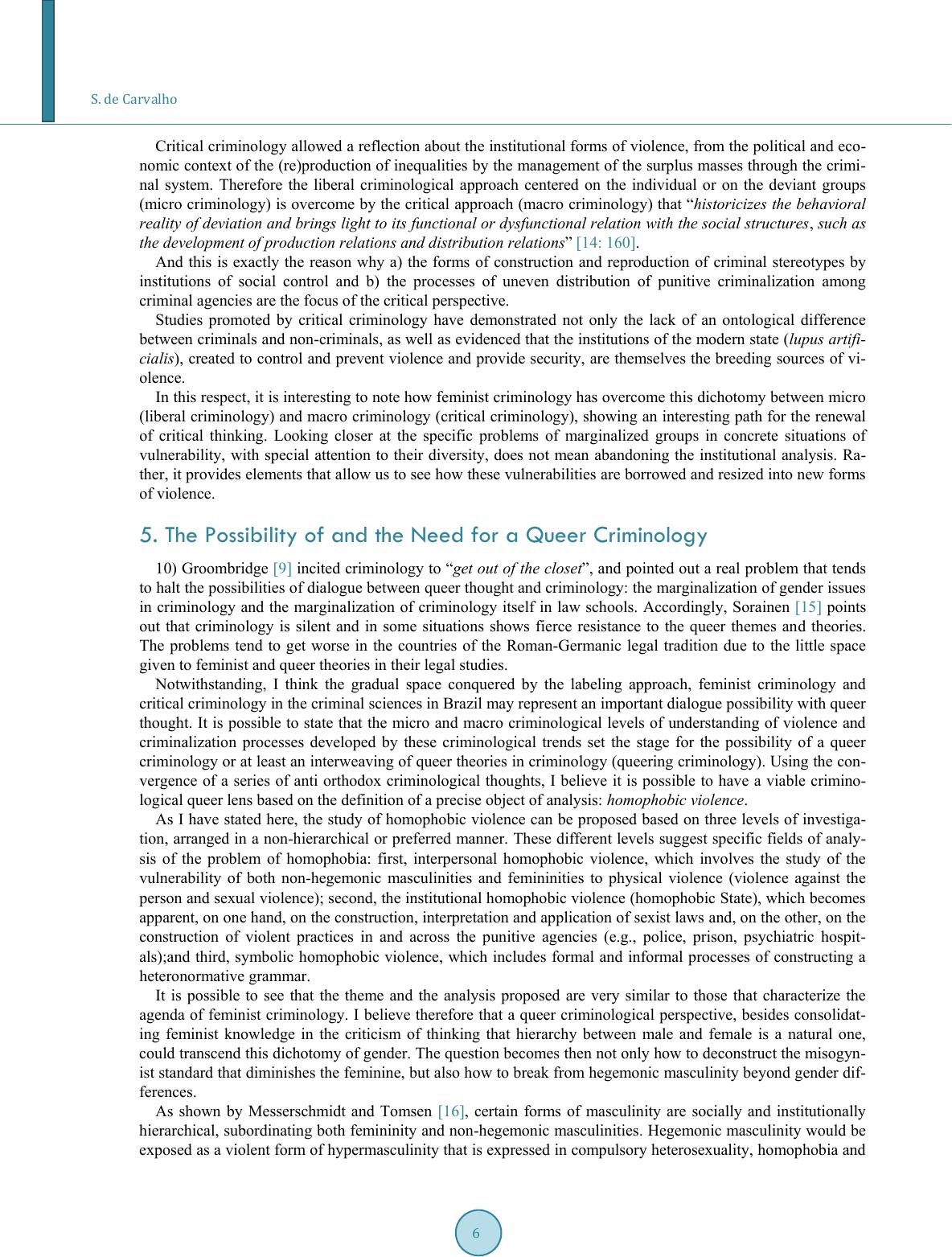 S. de Carvalho Critical criminology allow ed a reflection about the institution al forms of violence, from the political an d eco- nomic context of the (re)production of inequalities by the management of the surplus masses through the crimi- nal system. Therefore the liberal criminological approach centered on the individual or on the deviant groups (micro criminology) is overcome by the critical approach (macro criminology) that “historicizes the behavioral reality of deviation and brings ligh t to its functional or dysfunctional relation with the social structures , such as the development of production relations and distribution relations” [14: 160]. And this is exactly the reason why a) the forms of construction and reproduction of criminal stereotypes by institutions of social control and b) the processes of uneven distribution of punitive criminalization among criminal agencies are the focus of the critical perspective. Studies promoted by critical criminology have demonstrated not only the lack of an ontological difference between criminals and non-criminals, as well as eviden ced that the institutions of the modern state ( lupus artifi- cialis), created to control and prevent violence and provide security, are themselves the breeding sources of vi- olence. In this respect, it is interesting to note how feminist criminology has overcome this dichotomy between micro (liberal criminology) and macro cr iminology (critical criminology), showing an interestin g path for the renewal of critical thinking. Looking closer at the specific problems of marginalized groups in concrete situations of vulnerability, with special attention to their diversity, does not mean abandoning the institutional analysis. Ra- ther, it provides elements that allow us to see how these vulnerabilities are borrowed and resized into new forms of violence. 5. The Possibility of and the Need for a Queer Criminology 10) Groombridge [9] incited criminology to “get out of the closet”, and pointed out a real problem that tends to halt the possibilities of dialogue between queer thought and criminology: the marginalization of gender issues in criminology and the marginalization of criminology itself in law schools. Accordingly, Sorainen [15] points out that criminology is silent and in some situations shows fierce resistance to the queer themes and theories. The problems tend to get worse in the countries of the Roman-Germanic legal tradition due to the little space given to feminist and queer theories in their legal studies. Notwithstanding, I think the gradual space conquered by the labeling approach, feminist criminology and critical criminology in the criminal sciences in Brazil may represent an important dialogue possibility with queer thought. It is possible to state that the micro and macro criminological levels of understanding of violence and criminalization processes developed by these criminological trends set the stage for the possibility of a queer criminology or at least an interweaving of queer theories in criminology (que ering criminology). Using the con - vergence of a series of anti orthodox criminological thoughts, I believe it is possible to have a viable crimino- logical queer lens based on the definition of a precise object of analysis : homophobic violence. As I have stated here, the study of homophobic violence can be proposed based on three levels of investiga- tion, arranged in a non-hierarchical or preferred manner. These different levels suggest specific fields of analy- sis of the problem of homophobia: first, interpersonal homophobic violence, which involves the study of the vulnerability of both non-hegemonic masculinities and femininities to physical violence (violence against the person and sexual violence); second, the institutional homophobic violence (homophobic State), which becomes apparent, on one hand, on the construction, interpretation and application of sexist laws and , on the oth er, on the construction of violent practices in and across the punitive agencies (e.g., police, prison, psychiatric hospit- als);and third, symbolic homophobic violence, which includes formal and informal processes of constructing a heteronormative grammar. It is possible to see that the theme and the analysis proposed are very similar to those that characterize the agenda of feminist criminology. I believe therefore that a queer criminological perspective, besides consolidat- ing feminist knowledge in the criticism of thinking that hierarchy between male and female is a natural one, could transcend this dichotomy of gender. The question becomes then not only how to deconstruct the misogyn- ist standard that diminishes the feminine, bu t also how to break from hegemonic masculinity beyond gender dif- ferences. As shown by Messerschmidt and Tomsen [16], certain forms of masculinity are socially and institutionally hierarchical, subordinating both femininity and non-hegemonic masculinities. Hegemonic masculinity w ould be exposed as a violent form of hypermasculinity that is expressed in compulsory heterosexuality, homophobia and 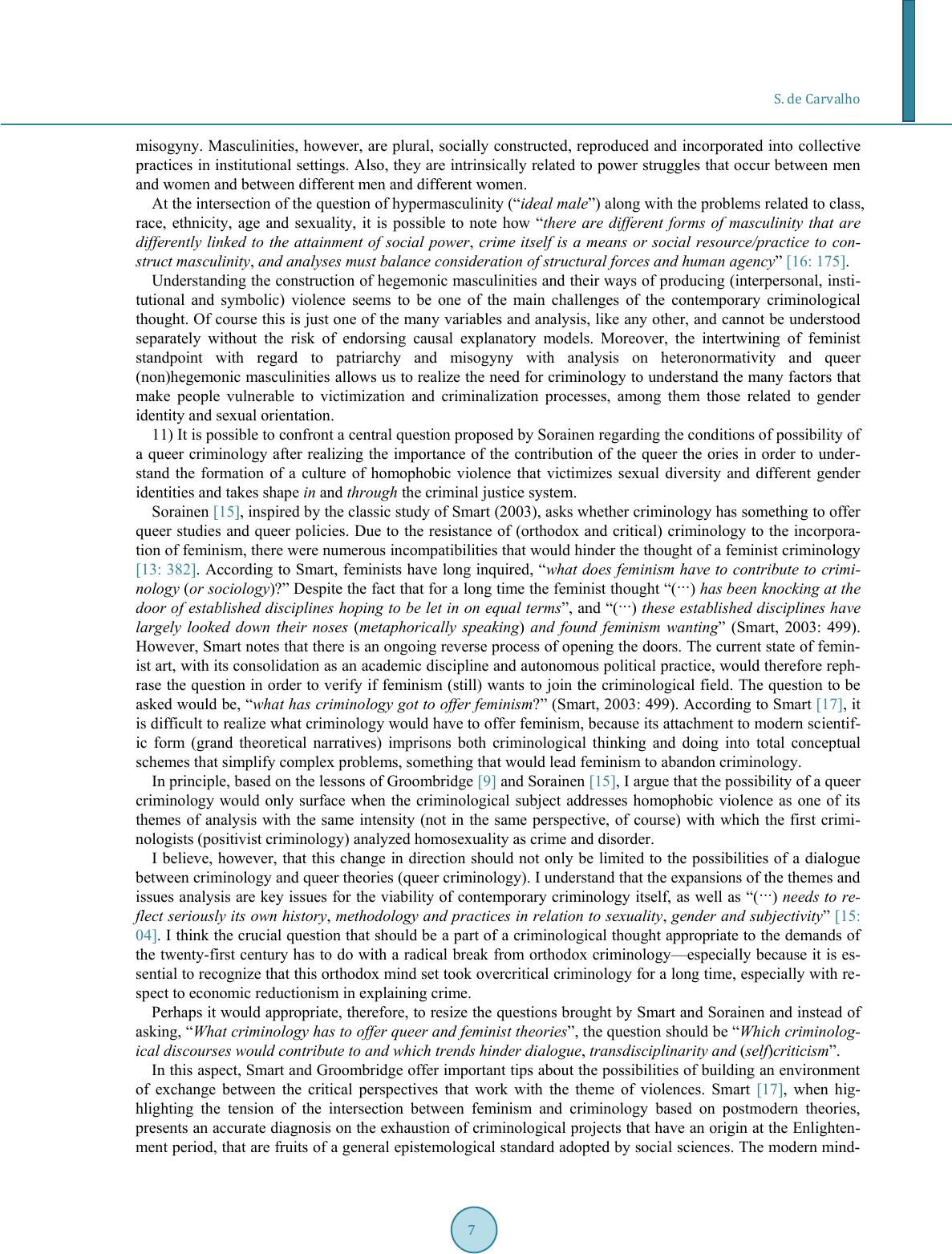 S. de Carvalho misogyny. Masculinities, however, are plural, socially constructed, reproduced and incorporated into collective practices in institutional settings. Also, they are intrinsically related to power struggles that occur between men and women and between different men and different women. At the intersection of the question of hypermasculinity (“ideal male”) along with the problems related to class, race, ethnicity, age and sexuality, it is possible to note how “there are different forms of masculinity that are differently linked to the attainment of social power, crime itself is a means or social resource/practice to con- struct masculinity, and analyses mus t balance consider at ion of str uc tural forces an d human age nc y” [16: 1 75]. Understanding the construction of hegemonic masculinities and their ways of producing (interpersonal, insti- tutional and symbolic) violence seems to be one of the main challenges of the contemporary criminological thought. Of course this is just one of the many variables and analysis, like any other, and cannot be understood separately without the risk of endorsing causal explanatory models. Moreover, the intertwining of feminist standpoint with regard to patriarchy and misogyny with analysis on heteronormativity and queer (non)hegemonic masculinities allows us to realize the need for criminology to understand the many factors that make people vulnerable to victimization and criminalization processes, among them those related to gender identity and sexual orientation. 11) It is possible to confront a central question proposed by Sorainen regarding the conditions of possibility of a queer criminology after realizing the importance of the contribution of the queer the ories in order to under- stand the formation of a culture of homophobic violence that victimizes sexual diversity and different gender identities and takes shape in and through the criminal justice system. Sorainen [15], inspired by the classic study of Smart (2003), asks whether criminology has something to offer queer studies and queer policies. Due to the resistance of (orthodox and critical) criminology to the incorpora- tion of feminism, there were numerous incompatibilities that would hinder the thought of a feminist criminology [13: 382]. According to Smart, feminists have long inquired, “what does feminism have to contribute to crimi- nology (or sociology)?” Despite the fact that for a long time the feminist thought “( ···) has been knocking at the door of established disciplines hoping to be let in on equal terms”, and “(···) these established disciplines have largely looked down their noses (metaphorically speaking) and found feminism wanting” (Smart, 2003: 499). However, Smart notes that there is an ongoing reverse process of opening the doors. The current state of femin- ist art, with its conso lidation as an academic discipline and autonomous political practice, would therefore reph- rase the question in order to verify if feminism (still) wants to join the criminological field. The question to be asked would be, “what has criminology got to offer feminism? ” (Smart, 2003: 499). According to Smart [ 17], it is difficult to realize what criminology would have to offer feminism, because its attachment to modern scientif- ic form (grand theoretical narratives) imprisons both criminological thinking and doing into total conceptual schemes that simplify complex problems, something that would lead feminism to abandon criminology. In principle, based on the lessons of Groombridge [9] and Sorainen [15], I argue that the possibility of a queer criminology would only surface when the criminological subject addresses homophobic violence as one of its themes of analysis with the same intensity (not in the same perspective, of course) with which the first crimi- nologists (positivist criminology) analyzed homosexuality as crime and disorder. I believe, however, that this change in direction should not only be limited to the possibilities of a dialogue between criminology and queer theories (queer criminology). I understand that the expansions of the themes and issues analysis are key issues for the viability of contemporary criminology itself, as well as “(···) needs to re- flect seriously its own history, methodology and practices in relation to sexuality, gender and sub jectivity” [15: 04]. I think the crucial question that should be a part of a criminological thought appropriate to the demands of the twenty-first century has to do with a radical break from orthodox criminology—especially because it is es- sential to recognize that this or thodox mind set took overcritical criminolog y for a long time, especially with re - spect to economic reductionism in explaining crime. Perhaps it would appropriate, therefore, to resize the questions brought by Smart and Sorainen and instead of asking, “What criminology has to o ffer queer and feminist th eories ”, the question should be “Which criminolog- ical discourses would contribute to and which trends hinder dialogue, transdisciplinarity and (self)criticism”. In this aspect, Smart and Groombridge offer important tips about the possibilities of building an environment of exchange between the critical perspectives that work with the theme of violences. Smart [17], when hig- hlighting the tension of the intersection between feminism and criminology based on postmodern theories, presents an accurate diagnosis on the exhaustion of criminological projects that have an origin at the Enlighten- ment period, that are fruits of a general epistemological standard adopted by social sciences. The modern mind- 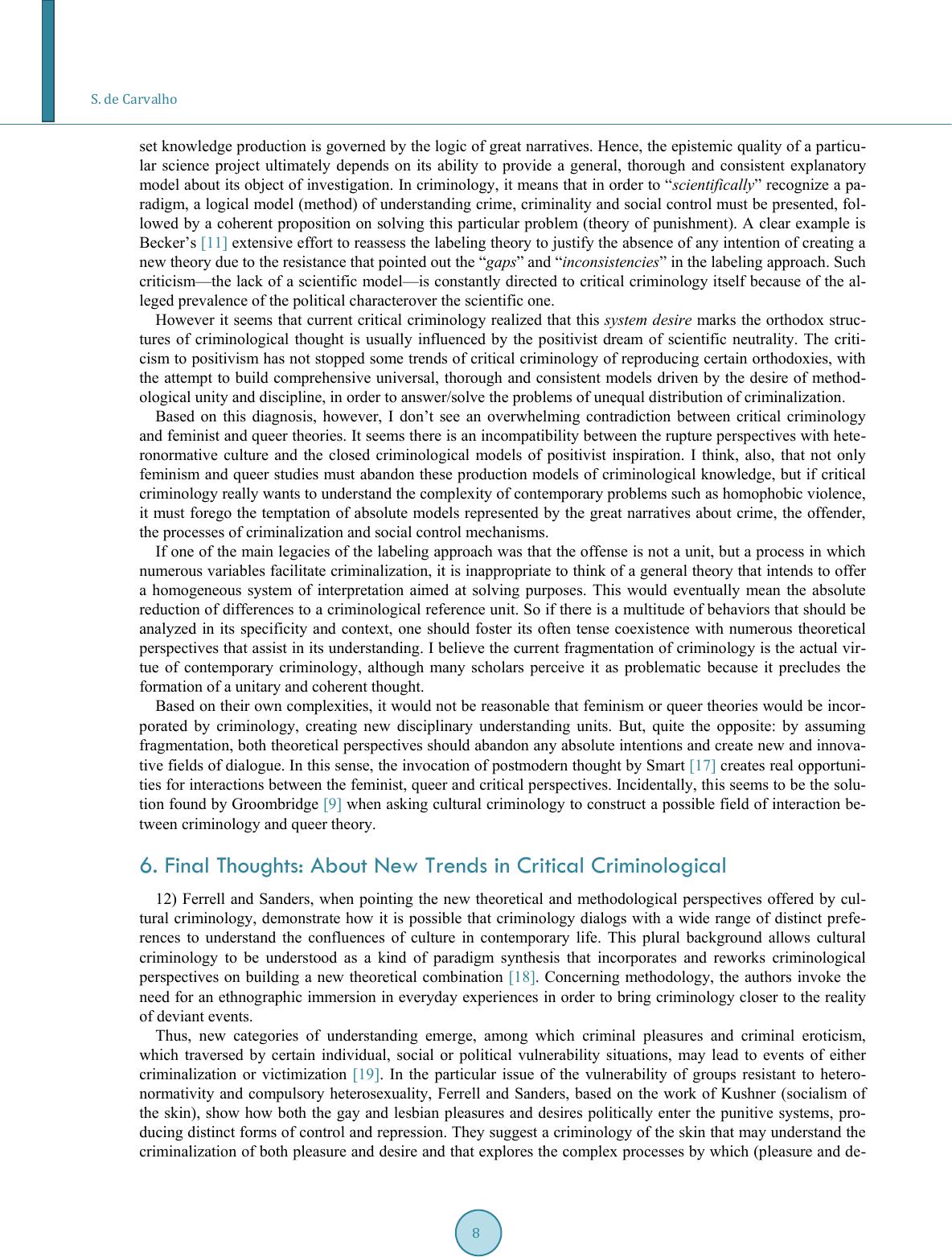 S. de Carvalho set knowledge produ ction is governed by the log ic of great narratives. Hence , the epistemic quality of a particu - lar science project ultimately depends on its ability to provide a general, thorough and consistent explanatory model about its object of investigation. In criminology, it means that in order to “scientifically” recognize a pa- radigm, a logical model (method) of understanding crime, criminality and social control must be presented, fol- lowed by a coherent proposition on solving this particular problem (theory of punishment). A clear example is Becker’s [11] extensive effort to reassess the labeling theory to justify the absence of any intention of creating a new theory due to the resistance that pointed out the “gaps” and “inconsistencies” in the labeling approach. Such criticism—the lack of a scientific model—is constantly directed to critical criminology itself because of the al- leged prevalence of the political characterover the scientific one. However it seems that current critical criminology realized that this system desire marks the orthodox struc- tures of criminological thought is usually influenced by the positivist dream of scientific neutrality. The criti- cism to positivism has not stopped some trends of critical criminology of reproducing certain orthodoxies, with the attempt to build comprehensive universal, thorough and consistent models driven by the desire of method- ological unity and discipline, in order to answer/solve the problems of unequal distribution of criminalization. Based on this diagnosis, however, I don’t see an overwhelming contradiction between critical criminology and feminist and queer theories. It seems there is an incompatibility between the rupture perspectives with hete- ronormative culture and the closed criminological models of positivist inspiration. I think, also, that not only feminism and queer studies must abandon these production models of criminological knowledge, but if critical criminology really wants to understand the complexity of contemporary problems such as homophobic violence, it must forego the temptation of absolute models represented by the great narratives about crime, the offender, the processes of criminalization and social control mechanisms. If one of the main legacies of the labeling approach was that the offense is not a unit, but a process in which numerous variables facilitate criminalizatio n, it is inappropriate to think of a general theory that inten ds to o ffer a homogeneous system of interpretation aimed at solving purposes. This would eventually mean the absolute reduction of differences to a criminological reference unit. So if there is a multitude of behaviors that should be analyzed in its specificity and context, one should foster its often tense coexistence with numerous theoretical perspectives that assist in its understanding. I believe the current fragmentation of criminology is the actual vir- tue of contemporary criminology, although many scholars perceive it as problematic because it precludes the formation of a unitary and coherent thought. Based on their own complexities, it would not be reasonable that feminism or queer theories would be incor- porated by criminology, creating new disciplinary understanding units. But, quite the opposite: by assuming fragmentation, both theoretical perspectives should abandon any absolute intentions and create new and innova- tive fields of dialogue. In this sense, the invocation of postmodern thought by Smar t [17] creates real opportuni- ties for interactions betw een the feminist, queer and critical persp ectives. Incidentally, th is seems to be th e solu- tion found by Groombridge [9] when asking cultural criminology to construct a possible field of interaction be- tween cri minology and queer theory. 6. Final Thoughts: About New Trends in Critical Criminological 12) Ferrell and Sanders, when pointing the new theoretical and methodological perspectives offered by cul- tural criminology, demonstrate how it is possible that criminology dialogs with a wide range of distinct prefe- rences to understand the confluences of culture in contemporary life. This plural background allows cultural criminology to be understood as a kind of paradigm synthesis that incorporates and reworks criminological perspectives on building a new theoretical combination [18]. Concerning methodology, the authors invoke the need for an ethnographic immersion in everyday experiences in order to bring criminology closer to the reality of deviant events. Thus, new categories of understanding emerge, among which criminal pleasures and criminal eroticism, which traversed by certain individual, social or political vulnerability situations, may lead to events of either criminalization or victimization [19]. In the particular issue of the vulnerability of groups resistant to hetero- normativity and compulsory heterosexuality, Ferrell and Sanders, based on the work of Kushner (socialism of the skin), show how both the gay and lesbian pleasures and desires politically enter the punitive systems, pro- ducing distinct forms of control and repression. They suggest a criminology of the skin that may understand the criminalization of both pleasure and desire and that explores the complex processes by which (pleasure and de- 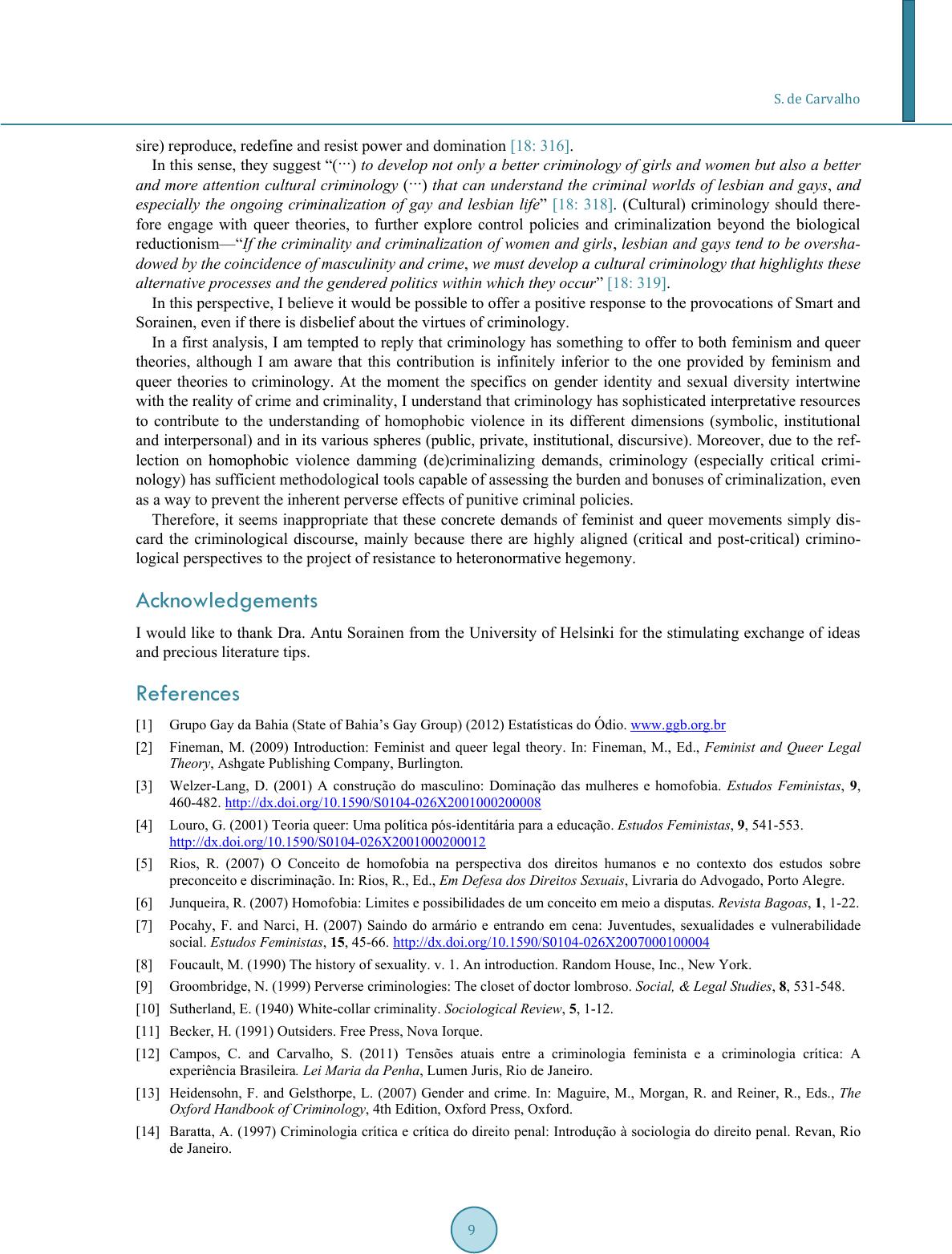 S. de Carvalho sire) reproduce, redefine and resist power and domination [18: 3 16]. In this sense, they suggest “(···) to develop not only a better criminology of girls and women but also a better and more attention cultural criminology (···) that can understand the criminal worlds of lesbian and gays, and especially the ongoing criminalization of gay and lesbian life” [18: 318]. (Cultural) criminology should there- fore engage with queer theories, to further explore control policies and criminalization beyond the biological reductionism—“If the crim inality and criminalization of women and girls , lesbian and gays tend to be ov ersha- dowed by the coinci dence of mas culini t y and crime, we must develop a cultural criminology that highlights these alternative processes and the gendered politics within which they occur” [18: 319] . In this perspective, I b elieve it would be possible to offer a positive respons e to the provocatio ns of S mart and Sorainen, even if there is disbelief about the virtues of criminology. In a first analysis, I am tempted to reply that criminology has something to offer to both feminism and queer theories, although I am aware that this contribution is infinitely inferior to the one provided by feminism and queer theories to criminology. At the moment the specifics on gender identity and sexual diversity intertwine with the reality of crime and criminality, I u nderstand tha t criminology has soph isticated interpretativ e resources to contribute to the understanding of homophobic violence in its different dimensions (symbolic, institutional and interpersonal) and in its various spheres (public, private, institutional, discursive). Moreover, due to the ref- lection on homophobic violence damming (de)criminalizing demands, criminology (especially critical crimi- nology) has sufficient methodological tools capable of assessing the burden and bonuses of criminalizatio n, even as a way to prevent the inherent perverse effects of punitive criminal policies. Therefore, it seems inappropriate that these concrete demands of feminist and queer movements simply dis- card the criminological discourse, mainly because there are highly aligned (critical and post-critical) crimino- logical perspectives to the project of resistance to heteronormative hegemony. Acknowledgements I would like to thank Dra . Antu Sorainen from the University of He lsinki for the stimulating exchange of ideas and precious literature tips. References [1] Grupo Gay da Bahia (State of Bahia’s Gay Group) (2012) Estatísticas do Ódio. www.ggb.org.br [2] Fineman, M. (2009) Introduction: Feminist and queer legal theory. In: Fineman, M., Ed., Feminist and Queer Legal Theory, Ashgate Publishing Company, Burlington. [3] Welzer-Lang, D. (2001) A construção do masculino: Dominação das mulheres e homofobia. Estudos Feministas, 9, 460-482. http://dx.doi.org/10.1590/S0104-026X2001000200008 [4] Louro, G. (2001) Teoria queer: Uma política pós-identitária para a educação. Estudos Feministas, 9, 541-553. http://dx.doi.org/10.1590/S0104-026X2001000200012 [5] Rios, R. (2007) O Conceito de homofobia na perspectiva dos direitos humanos e no contexto dos estudos sobre preconceito e discriminação. In: Rios, R., Ed., Em Defesa dos Direitos Sexuais, Livraria do Advogado, Porto Alegre. [6] Junqueira, R. (2007) Homofobia: Limites e possibilidades de um conceito em meio a disputas. Revista Bagoas, 1, 1-22. [7] Pocahy, F. and Narci, H. (2007) Saindo do armário e entrando em cena: Juventudes, sexualidades e vulnerabilidade social. Estudos Feministas, 15, 45-66. http://dx.doi.org/10.1590/S0104-026X2007000100004 [8] Foucault, M. (1990) The history of sexuality. v. 1. An introduction. Random House, Inc., New York. [9] Groombridge, N. (1999) Perverse criminologies: The closet of doctor lombroso. Social, & Legal Studies, 8, 531-548. [10] Sutherland, E. (1940) White-collar criminality. Sociological Review, 5, 1-12. [11] Becker, H. (1991) Outsiders. Free Press, Nova Iorque. [12] Campos, C. and Carvalho, S. (2011) Tensões atuais entre a criminologia feminista e a criminologia crítica: A experiência Brasileira. Lei Maria da Penha, Lumen Juris, Rio de Janeiro. [13] Heidensohn, F. and Gelsthorpe, L. (2007) Gender and crime. In: Maguire, M., Morgan, R. and Reiner, R., Eds., The Oxford Handbook of Criminology, 4th Edition, Oxford Press, Oxford. [14] Baratta, A. (1997) Criminologia crítica e crítica do direito penal: Introdução à sociologia do direito penal. Revan, Rio de Janeiro.  S. de Carvalho [15] Sorainen, A. (2003) Queering criminology. Annual Conference of the European Society of Criminology “Crime and Control in an Integrating Europe”, University of Helsinki, Helsinki. [16] Messerschmidt, J.W. and Tomsen, S. (2012) Masculinities. In: DeKeseredy, W.S. and Dragiewicz, M., Eds., Routledge Handbook of Critical Criminology, Routledge, Nova Iorque. [17] Smart, C. (2005) Feminist approaches to criminology or postmodern woman meets atavistic man. In: Gelsthorpe, L. and Morris, A., Eds., Criminological Perspectives: Essential Readings, 2nd Edition, Sage , Londres. [18] Ferrell, J. and Sanders, C. (2008) Toward a cul tural criminology. In: Ferrell, J. and Sanders, C., Eds., Cultural Crimi- nology, Northeastern University Press, Boston. [19] Ferrell, J., Hayward, K. and Young, J. (2008) Cultural criminology: An invitation. Sage, Londres.
|